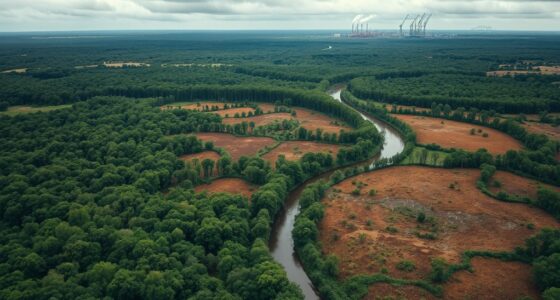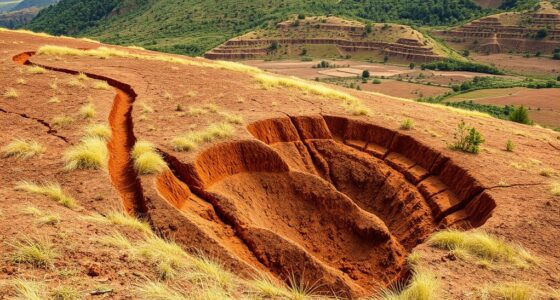Planetary boundaries define Earth’s natural limits that support your life sustainably. If we push beyond these thresholds, we risk destabilizing essential systems like climate, land, and biodiversity, which can lead to unpredictable and dangerous consequences. Understanding these limits helps you see how responsible actions protect the planet and guarantee long-term stability. Continuing this exploration reveals how you can contribute to maintaining Earth’s resilience and safeguarding a sustainable future for everyone.
Key Takeaways
- Planetary boundaries define Earth’s natural limits to prevent destabilizing environmental changes.
- Crossing these thresholds risks irreversible damage to ecosystems and human well-being.
- Understanding limits guides sustainable practices like agriculture, land use, and pollution control.
- Maintaining these boundaries ensures Earth’s resilience against climate change and biodiversity loss.
- Collective responsibility and informed policies are essential to stay within safe operating limits.

Have you ever wondered how much human activity our planet can handle before it starts to break down? It’s a crucial question, especially as we face escalating environmental challenges. Our planet has natural limits—called planetary boundaries—that define the safe operating space for humanity. Crossing these thresholds risks de-stabilizing Earth’s systems, leading to unpredictable and potentially catastrophic consequences. One key boundary involves how we manage land and food production, specifically through sustainable agriculture. If we push agricultural practices beyond their capacity, we risk depleting soil nutrients, increasing pollution, and reducing biodiversity, all of which threaten the resilience of our ecosystems. Sustainable agriculture aims to balance food production with environmental health, ensuring that farming methods do not exhaust resources or cause irreversible damage. By adopting practices like crop rotation, organic farming, and reduced chemical use, you help maintain soil fertility and support the Earth’s climate resilience. These practices help preserve the land’s capacity to produce food over the long term, preventing land degradation and reducing greenhouse gas emissions associated with conventional farming. Additionally, understanding Earth’s natural limits is essential for developing policies that safeguard against crossing dangerous thresholds. Recognizing the importance of integrated environmental management can enhance our ability to stay within safe planetary boundaries and protect ecosystem services vital for our survival. Climate resilience is another critical aspect of staying within planetary boundaries. It refers to the ability of communities and ecosystems to adapt to climate change and withstand its impacts. When we push past safe limits—by emitting excessive greenhouse gases, for example—we accelerate climate change, leading to more frequent and severe weather events, rising sea levels, and loss of biodiversity. Building climate resilience involves not only reducing emissions but also investing in infrastructure, policies, and community practices that help us adapt to changes that are already unavoidable. Moreover, fostering public awareness about the importance of respecting planetary boundaries encourages collective action and responsible decision-making. An increased focus on sustainable development can help guide our efforts to live within Earth’s capacity while improving quality of life for all. For you, this might mean supporting renewable energy, reducing waste, or advocating for policies that protect vulnerable ecosystems. Strengthening climate resilience ensures that we don’t just survive environmental shocks but can recover and thrive despite them. Understanding and respecting these boundaries isn’t just about protecting nature; it’s about safeguarding our future. When human activities like deforestation, pollution, and unsustainable agriculture go unchecked, we risk pushing Earth beyond its safe limits. But by making conscious choices—supporting sustainable agriculture, reducing carbon footprints, and promoting ecosystem health—you contribute to maintaining the stability of Earth’s systems. Staying within planetary boundaries keeps the environment resilient, ensuring that the planet can continue supporting life as we know it. Ultimately, it’s a shared responsibility that calls for awareness, action, and a commitment to living within the planet’s capacity. That way, we can secure a healthier, more stable future for ourselves and generations to come.
Frequently Asked Questions
How Are Planetary Boundaries Measured and Monitored Globally?
You can understand how planetary boundaries are measured and monitored worldwide through satellite monitoring and ecological indicators. Satellites track changes in land use, deforestation, and climate variables, providing real-time data. Ecological indicators like biodiversity, ocean acidity, and greenhouse gas levels help assess Earth’s health. Combining these tools, scientists continuously analyze data to guarantee human activities stay within safe limits, safeguarding the planet’s essential systems for future generations.
Can Planetary Boundaries Be Expanded or Are They Fixed Limits?
Did you know that nearly 70% of scientists agree that boundaries should be adaptable? You might wonder if these limits can be expanded or if they’re fixed. The truth is, boundary flexibility allows for threshold adjustments based on new data and evolving understanding. While some limits are considered fixed, many can shift to reflect Earth’s changing systems, helping us better manage risks and maintain a sustainable balance.
What Role Do Technological Innovations Play in Maintaining Boundaries?
Technological innovations play a vital role in maintaining Earth’s boundaries by providing solutions to pressing environmental challenges. You can leverage technological solutions to reduce pollution, conserve resources, and monitor ecological changes. However, you should be aware of innovation challenges, like ensuring these technologies are sustainable and accessible. Embracing innovation helps you stay proactive in protecting our planet, but it requires careful planning and responsible implementation to be truly effective.
How Do Local Policies Influence Planetary Boundary Safety?
Imagine you’re in the 21st century, where local governance and policy enforcement directly shape environmental health. Your community’s policies can limit pollution, conserve resources, and protect ecosystems, ensuring safety within planetary boundaries. Effective local policies foster responsible resource management and hold industries accountable. When policies are enforced consistently, you help maintain Earth’s delicate balance, preventing ecological tipping points and supporting long-term sustainability for everyone.
What Are the Economic Implications of Crossing Planetary Boundaries?
You need to contemplate the economic implications of crossing planetary boundaries through cost-benefit analysis. When boundaries are exceeded, costs like environmental damage and resource scarcity increase, affecting long-term growth. This pressures sustainable development, as short-term gains may lead to costly remediation and reduced productivity later. Balancing immediate benefits against future risks encourages smarter policies that promote economic stability while respecting Earth’s limits, ensuring a sustainable future for all.
Conclusion
Think of Earth’s boundaries as the lines in a delicate dance—step too far, and the rhythm falters. By respecting these limits, you help keep our planet’s dance graceful and sustainable. Ignoring them risks throwing the entire choreography into chaos. Stay mindful of your actions, and remember, you’re part of this grand performance. Together, we can ensure Earth continues to spin in harmony, maintaining its vibrant rhythm for generations to come.










